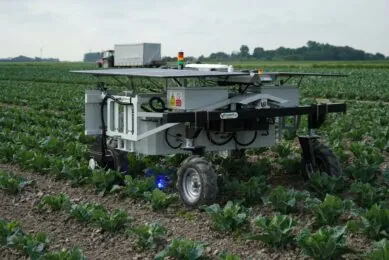Will wireless charging promote the adoption of field robots?

Wiferion has gained quite a position in wireless charging of autonomous warehousing robots and is now also targeting agricultural field robots.
On the occasion of the recent World FIRA ag robotics forum, Johannes Mayer, managing director and cofounder of German start-up company Wiferion explained why he feels that agricultural robots could benefit from their patented wireless charging systems for industrial electric vehicles and mobile robots.
Charging autonomous mobile robots
Wiferion was founded as Blue Inductive in 2016 by four former employees of the German Fraunhofer Institute for Solar Energy Systems and is considered to be one of the driving companies in the field of wireless charging. The company not only offers inductive charging technology but also lithium-ion batteries and energy cloud management solutions.
Text continues underneath video
Since the start of the company, they have been focussing on wireless inductive charging of automated guided vehicles (AGV’s), forklifts and autonomous mobile robots (AMR’s). Mostly in indoor and controlled circumstances. The best thing about inductive charging – alike charging your electrical toothbrush and some robotic lawnmowers – is that you don’t need to plug in any cables nor need to swap batteries. It enables true autonomy and that’s a big advantage for warehousing robots.
Efficiency of wireless charging is 93 percent
Wiferion claims that the efficiency of wireless charging is 93 percent, the same as cable charging. To do so, you need a wallbox powering a charging pad, a 25 by 25 cm receiver underneath the robot and a small electronic box on the robot. The positioning of the receiver above the charging pad has a tolerance of 4 cm in each direction and the charger can charge all common battery types regardless of cell chemistry.
Text continues underneath image

Potential in agriculture?
During the EIMA exhibition in November 2021 in Italy, its organiser, branch organisation FederUnacoma, indicated that of the agricultural robots produced, 78 percent is powered electrically. Some of the field robots in the Future Farming robot catalogue are also equipped with solar panels to charge the batteries while working during day time. Such as the Directed Machines Land Care Robot, FarmDroid FD20, Pixelfarming Robot One and the Vitirover. Depending on the hours and intensity of the sun, these will still need charging and could thus benefit from wireless charging.
Text continues underneath image

The Wiferion solutions are IP65 certified (protection against low pressure water jets) and thus suitable for outdoor use. The company also says their system has no open or live contacts or connectors so dust and dirt do not affect the reliable power supply. There are also some potential challenges such as field robot ground clearances that indoor AGV’s and AMR’s don’t have. Besides, you have to have a power supply for the wireless charging station and that’s not likely to be found on the average field.
Nonetheless, it could help speed up the adoption of field robots and accelerate true autonomy of electrically driven field robots.
Also read: Why the overall adoption rate of agricultural robots is still low
Join 17,000+ subscribers
Subscribe to our newsletter to stay updated about all the need-to-know content in the agricultural sector, two times a week.



